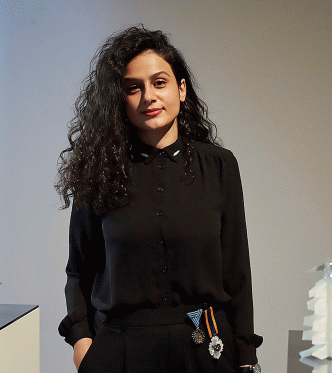Neda Saeedi
Artistic Research Fellow

Born in Tehran/Iran, Neda Saeedi lives and works in Berlin. She studied classical sculpture under the direction of Raffie Davtian in Tehran and later Fine Arts at the LensBased Class of Prof. Hito Steyelr at Berlin University of Arts (UdK). She is the recipient of the Kunstfonds Scholarship 2020, The Elsa Neumann Emerging Artist Prize 2019 and the Research Grant of the Berlin Senate for Culture and Europe in 2018. She is an alumni of the Delfina Foundation Artist Residency in London.
Saeedi has exhibited her work at galleries, museums and art spaces internationally – such as Taxi_Palais Tiroler Kunsthalle, Austria; Staatliche Kunsthalle Baden-Baden, Germany; Extra City, Antwerp; Luleå Biennial 2018; Ludlow 38, New York; Bonner Bundeskunsthalle; Folkwang Museum, Essen and Savvy Contemporary, Berlin; Künstlerhaus Bethanien, Berlin; Sharjah Biennial 2011; Dastan Gallery, Tehran (solo); Argo Factory, Tehran (solo); New Viewings at Barbara Thumm Gallery (online). Her publication RETURN TO NEVERLAND – A CONVERSATION BETWEEN NEDA SAEEDI & HOMAYOUN SIRIZI has been published (in Farsi and English) by Pejman Foundation and was released in the summer of 2021.
The Artistic Research Fellowship is a collaboration between Kunsthistorisches Institut in Florenz – Max-Planck-Institut and Villa Romana Florence.
- urbanism and architecture
- alternative historiography
- environmental justice
- sociopolitical effects of development projects in relation to environmental effects
- post colonial studies
- agriculture and botanical studies
- theology
Saeedi is intrigued by the power dynamics surrounding the processes through which the crystallization and hi-story of places are constructed and consumed. She investigates the historical and political resonance of materials and the physical relationships between objects and bodies, drawing from sources such as the symbolism of architecture and urban planning. As such, her concerns and methods typically examine the documents, materials, and structures that together form the substrate upon which these processes are built; she reanimates these hi-stories through the use of spatial settings and the materiality of objects, often drawing on human or non-human bodies.
Her installations and sculptures explore how power is articulated through relationships, often focusing on the body and materiality in relation to narratives of architecture and histories of place. Saeedi's current long-term project over the past several years has been devoted to exploring the concept of the garden and the practice of segregation, demarcation, and the semiotics of state and nature. Her focus is on the practice of gardens/gardening, where it juxtaposes possession and governing.
How can the consequences of modernisation and industrialisation for the environment be understood and translated sculpturally and spatially? Saeedi’s artistic research and practice evolves around a long-term project, the production of a series of research-based sculpture and installation works around the theme of land, construction, reconstruction and deconstruction of places and buildings and spaces. The formal and aesthetic focus of her ongoing exploration of these themes is the relationship between human beings and architecture and environment : the value, materiality, power and property of the body (human and nonhuman) in relation to urban and development projects. Here the consequences of modernization and industrialization for the environment are examined and translated into formal/sculptural form. In her artistic practice, she aims to tell the hi-stories through objects and materials and their spatial arrangement. She is interested in historiography and the telling of stories through sculptural and installation form.
Saeedi's current long-term project over the past several years has been devoted to exploring the notion of garden and the practice of segregation, demarcation, and evaluation. Her focus is on the practice of gardens/gardening: where it juxtaposes possession/governing and accessibility/depriving; where the apocalyptic depictions of the near future are rather manipulated/overseen through the false promises of the green salvation through the usage of new age gardens such as seed banks, the development of “gated communities”; the transformation of landscapes and the flora in conflict areas; and land ownership and dispossession.
Saeedi’s current projects Birds who fly the highest (working title) and Swear by the Fig, Swear by the Olive (working title) are the direct continuation of her latest installations, where the above mentioned thoughts are reflected and addressed by utilising the aesthetic and narratives of religious architecture.


